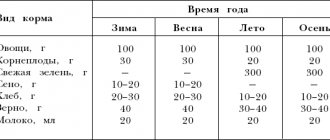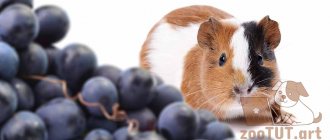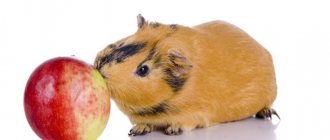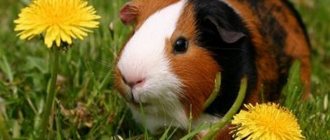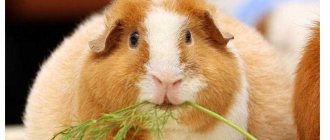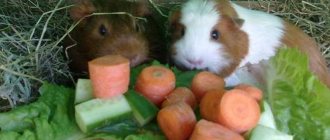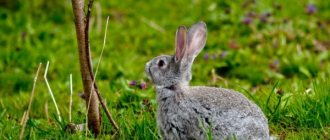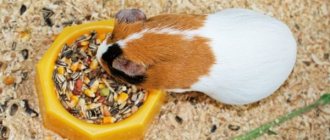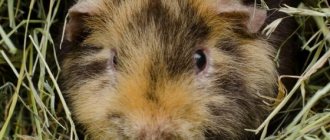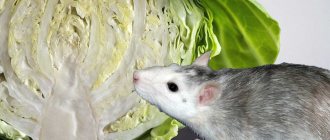Every pet owner wants to treat their pet to a certain treat. Berries or fruits may be ideal as a treat. These products are an important component of the animal's diet and should be included in its daily menu.
The animal’s body has an important feature: the animal is not capable of generating vitamin C on its own, unlike humans. Therefore, the deficiency of this vitamin must be replenished artificially with the help of additional supplements in the diet. If it is not replenished in a timely manner, the mumps may react with paralysis and a number of other health problems. But an excess of vitamin C in the pig’s body can cause skin problems and disturbances in the functioning of the kidney system.
A number of owners are wondering whether it is possible to compensate for vitamin C deficiency with a pear or an apple. It is necessary to take into account that the pear contains about 4.5 mg of vitamin C. In the winter season, the amount of vitamins in the pear is halved, as well as ascorbic acid. Despite all the usefulness of fruits, not all of these types of treats can be given to animals.
About vitamins and microelements
Including fresh vegetables and fruits in the diet of guinea pigs ensures complete feeding at home.
It is here that vital vitamins and microelements are contained, the lack of which can have tragic consequences. This reinforces the need to consume them like bread/grain all year round, as opposed to dry and fresh grass. Therefore, the answer to the question “Can guinea pigs be given bananas, grapes, apples or cabbage” is always affirmative. Their value is determined by the content of vitamin C, calcium, phosphorus - important elements for muscles, skeletal system, and metabolism. A lack of vitamin C can cause paralysis. Its consumption rate per 1 kg of weight is 15 mg, and during pregnancy increases to 30 mg.
Watermelon
Guinea pigs can be given a little watermelon during the summer season. Try to give ripe pulp, and it is advisable not to give the white part closer to the rind, since it is in this part that nitrates accumulate. For the same reason, pigs should not be given early vegetables. Watermelon is a diuretic, so indulge your pet with it infrequently.
The same goes for melon. This vegetable is given from your own garden or purchased in season. It is also not recommended to give melon frequently; it is very sweet and can contribute to the development of diabetes.
We tried to consider in as much detail as possible and give answers to the question “What vegetables can guinea pigs eat?” As you can see, most vegetables are not only possible, but also should be given to guinea pigs. The most important thing is a properly formulated and balanced diet for your pet, including products grown without chemicals. To keep your guinea pig healthy and cheerful, stick to proper nutrition and your pet will thank you with its playful behavior and healthy appearance.
So, we have dealt with the question of what vegetables can guinea pigs eat, but we described in this article whether your pet can eat grass. You may be interested in this information.
https://nalugah.ru/zhivotnovodstvo/morskie-svinki/chem-mozhno-i-nelzya-kormit-morskuyu-svinku.htmlhttps://msvinkam.ru/pitanie/chem-kormit-morskuyu-svinku.htmlhttps:// moy-homyachok.ru/morskie-svinki/kakie-ovoshhi-mozhno-morskim-svinkam.html
About the nuances of feeding
Based on this, one of these products (banana, grapes, apple, cabbage) can be given to the guinea pig 2 times a day (morning, evening). Even if you need to follow a diet, fruits are included in the diet in small doses.
In addition, it is extremely important that each time the fruits are fresh, washed. Leftover food should be removed after a couple of hours.
Feeding features include the need to consume one specific fruit per day. To avoid digestive problems, these and other fruits and vegetables are included in the menu gradually, without excessive fanaticism.
The diet should include fresh fruits and vegetables
Depending on the age of the guinea pigs, banana, apple, cabbage, grape food (but not as a treat) can and should be given at intervals:
- for cubs and pregnant pets – 4 times a day;
- adults – 2 times a day.
What to avoid
When feeding plant foods, you should not exceed the permissible limits. This refers to excessive consumption of sweet fruits. So, an abundance of apples and grapes in the diet can cause an upset stomach in a guinea pig. An excess of cabbage (white cabbage, Chinese cabbage, broccoli and other cruciferous plants) creates problems in gas formation in the digestive tract.
Unripe or, conversely, overripe vegetables and fruits should be excluded from the diet. They are unconditionally excluded if the slightest initial signs of decay are detected.
Following these simple rules will help maintain the necessary balance of nutrients in the pig’s body. This means that the animal will grow up healthy, active and delight all household members with its love of life!
What should you absolutely not give to your guinea pig?
- Radish. Due to the content of essential oils, which, when ingested, lead to irritation of the mucous membranes and respiratory tract, and also contribute to bloating.
- Dry peas lead to bloating.
- Potatoes, which largely consist of starch, are difficult to digest when they enter the stomach. You should especially not give green potato sprouts, as they contain a lot of poisonous solanine.
- Hot pepper should never be given, as it irritates the mucous membranes.
- Corn grains contain starch, which is poorly digestible and contributes to obesity.
- Citrus fruits can lead to complications such as skin irritation and oxidation of urine.
- Milk and lactic acid products cause diarrhea and bloating due to the lack of enzymes that are responsible for breaking down the components included in these products. Milk can only be given to females during lactation.
- Bread causes fermentation in the stomach, and white plus also provokes bloating.
- Nuts and seeds lead to obesity.
- Eggs because they contain animal protein.
- Dried vegetables and fruits negatively affect the intestines due to their high concentration of sugar.
Proportions of foods that should be followed during daily feeding:
| hay, which is the main food | 60-70% |
| dry special food | 5-10% (no more than one tablespoon) |
| succulent food | 30% |
It is very important that the pig receives vitamin C along with the food, since the rodent’s body is not able to produce it. A lack of vitamin C can cause scurvy, which causes loss of movement in the legs.
The daily vitamin intake should be 10-15 grams. This vitamin should not be added to drinks, as it quickly decomposes in water. Its substitutes are vegetables that contain this element, these include lettuce, tomatoes, spinach, asparagus, broccoli, parsley leaves and cabbage.
Other products
Bread
Can guinea pigs eat bread? It's better not to give.
- Fresh yeast bread takes a long time to digest and causes fermentation in the animal’s stomach.
- White bread causes bloating.
- Your pet can eat stale bread, but not often.
- Dried bread with seeds, sesame seeds and raisins can sometimes be offered to your pet as a treat.
Can guinea pigs eat nuts and seeds?
Nuts and seeds are among the allowed foods, but can cause obesity if their consumption is not limited. It is better to offer your pet almonds, walnuts or hazelnuts.
The seeds contain many components useful for the animal: fatty acids, calcium, sodium, phosphorus, proteins and vitamins. It is better to give peeled seeds and make sure that they are no more than 15% of the total feed.
Pet diet at home
The diet of guinea pigs should be varied, but without daily experiments, which can cause problems in the animal’s digestive system. Standard set of products:
- carrots (pumpkin, zucchini, beets),
- apple (hard pears, raspberries, apricots, peach);
- white or cauliflower;
- high-quality granulated food;
- greens (parsley, dill, clover, dandelion leaves, wood lice grass);
- unlimited quantities of hay.
In the summer season, carrot and beet tops, cucumbers from your garden and fresh grass are good complementary foods.
Vegetables
Vegetables that you can offer your pig and choose the types that she tolerates well:
- carrot;
- beet;
- zucchini;
- pumpkin;
- cauliflower;
- White cabbage;
- Bulgarian pepper;
- swede;
- turnip;
- green pea pods;
- cucumbers;
- tomatoes.
It is recommended to purchase home-grown vegetables grown without pesticides. They can be dried for the winter or frozen.
As for cabbage, the opinions of breeders are divided. Sometimes it is recommended to completely exclude this product from the pig’s diet so as not to provoke bloating. However, cabbage in very limited quantities is extremely useful for the animal, as it contains many substances that prevent obesity.
Fruits and berries
Fruits and berries of your pet's choice:
- apples;
- pears;
- peaches;
- apricots;
- plums;
- cherry;
- cherries;
- citrus;
- blackberry;
- raspberries;
- strawberry.
Each type of fruit and berry is offered to the pigs one at a time and their health is monitored. Some berries can cause an allergic reaction.
Fresh greens, grass and hay
You can safely give a wide variety of greens, provided that they are clean, fresh, and not treated with chemicals:
- dill/parsley;
- spinach, lettuce, celery;
- greens of sprouted wheat and oats;
- leaves of strawberries, raspberries, currants, gooseberries;
- carrot and beet tops;
- meadow grass.
Everything picked in the forest and in the countryside must be thoroughly washed. If the pig is kept in a house with a garden plot, it makes sense to designate a garden bed where you can plant herbs specifically for the rodent. At home it is easy to grow clover and alfalfa, parsley, dill, lettuce, and garden quinoa.
You cannot collect grass for hay along the trails. As weeds in gardens you can find chickweed, acorn grass, wheatgrass, purslane, plantain and even nettle. These herbs can be given to the pig during the season, drying under a canopy. Wheatgrass produces high-quality hay for the winter. If you prepare hay in sufficient quantities, feeding your pet in winter will not be a problem. Dry the grass in such a way that it is not exposed to sunlight for at least one and a half months. The best option at home is an electric dryer, which will help you easily and quickly prepare not only herbs, but also organic fruits, vegetables, and berries for feeding the animal in the winter. A rodent always needs hay, so you need to take care of preparing it in advance.
How many times a day should you feed your guinea pig?
She is fed two to three times, provided that hay, as well as bowls of food and water, are constantly present in the cage. If the pig does not immediately try the fresh portion, it will definitely finish it after some time.
Juicy food is given, as a rule, in the first half of the day, and in the second half the emphasis shifts to dry food. With three meals a day, the rodent is given 1/3 tablespoon of dry food at one time, with two meals a day - half a tablespoon.
Having eaten the main provisions, the pig switches to dry grass: not only can it not starve, but it should not. An empty stomach causes intestinal stagnation.
Zucchini is a healthy vegetable
First, let's talk about the beneficial properties of zucchini and figure out what kind of vegetable it is. Nowadays, zucchini can be easily bought in a store at any time of the year, although, of course, in the summer - at the height of the season, it is most enriched with useful substances. In any case, zucchini is always rich in fiber, vitamins and minerals. The first one very gently and delicately normalizes the activity of the gastrointestinal tract, helps remove toxins from the body and prevents constipation.
Pectins in zucchini have a positive effect on liver function. It also contains a lot of liquid, which is good for digestion.
Vitamins and minerals contained in zucchini:
| Vitamin | Benefit |
| Vitamin C | Supports immunity |
| Vitamin B9 | Fights anemia |
| Vitamin PP | Supports proper organ function |
| Vitamin H | Good for the nervous system |
| Vitamin B3 | Supports proper organ function |
| Vitamin B6 | Important for the immune and nervous systems |
| Vitamin A | Helps improve vision |
| Vitamin B1 | Activates the work of all internal organs |
Minerals contained in zucchini and their beneficial properties:
| Mineral | Benefit |
| Iron | Important for good blood |
| Potassium | Necessary for normal functioning of skeletal muscles |
| Phosphorus | Strengthens bones and teeth |
| Magnesium | Supports heart rate |
| Sodium | Very important for the excretory and digestive systems of the body |
Zucchini in a guinea pig's diet
Now it is clear that zucchini is a vegetable that contains many elements necessary for the animal’s life, and therefore, when asked whether guinea pigs can have zucchini, we answer unequivocally in the affirmative.
This treat should be given to your pet no more than twice a week. Remember that zucchini contains a lot of sugars, so the portion of the vegetable for the pig should be moderate.
Can guinea pigs eat canned zucchini? Of course not. After all, canned vegetables contain a huge amount of salt and vinegar, as well as various hot seasonings, which is not safe for the animal.
You can give your guinea pig zucchini, alternating it with other healthy, juicy plant foods - pumpkin, carrots, cucumbers, tomatoes, beets. Diet variety is the key to a healthy pig.
Is it possible to give cooked zucchini to a guinea pig? You can, but not fried, but stewed with a little water. You can also add carrots and pumpkin to this stew.
Recommendations for preparing branch feed
First you need to understand the need to introduce branches into the diet.
Twigs can be used by animals as toys, which has a great effect on behavior, activity and sociability.
Rules for preparing branches yourself:
- Collecting food is required in areas that comply with environmental standards, and it is better to avoid highways, industrial areas and busy areas.
- It is best to pick a branch when the leaves are in the growing season. This is the most optimal period for receiving feed rich in nutrients.
- The stems should be free of fungi, lichens and traces of other diseases and pests.
- Before harvesting, the shoots are washed well in warm and then cold water, then the young branches are dried.
- The storage location is selected with a minimum percentage of humidity.
- The twig does not need to be cleared of bark, because it contains a large amount of nutrients, vitamins and minerals.
What branches are allowed to be fed to a chinchilla?
Constantly, on a daily basis, introducing bushes and trees into your diet is not the best idea, but you can safely diversify your diet with such tree branches by adding it to your diet along with other types of food:
- Hawthorn. It is necessary to properly prepare the food - remove leaves and thorns. A few branches twice a week are enough.
- Kalina. You can feed two stems once a week.
- Gooseberry. The shrub is cleared of thorns, after which 3 pieces are added to food every 7 days.
- Raspberries. You need to get rid of any elements that could cause harm. Escape can be given to an animal no more than once every 14 days.
- Sea buckthorn and rowan. All foliage is first removed, and you can give the animals a stalk a couple of times a week.
- Currant. You are allowed to take three branches and distribute them in a weekly ration.
- Mulberry. One tree shoot can be given to your pet once every 7 days.
- Birch. It is fed in the same way as alder. The stems of the tree are distinguished by a large number of vitamins and beneficial microelements. Particularly pleasing is the large number of phytoncides - substances with antimicrobial effects. Animals kept in cages often suffer from a lack of this element. The content of ascorbic acid in young foliage allows you to replenish the need for this vitamin. Greens are also rich in substances that have a beneficial effect on vital processes. You can provide your beloved pet with such a healthy treat all year round, but you don’t need to overdo it, because a large volume of leaves will negatively affect the functioning of the kidneys.
- Juniper. Rodents love both the coniferous component of the tree and berries, which contain large amounts of sugars that have bactericidal properties.
- Pine. The branches are rich in starch, various vitamins and a small amount of fat and iron. The latter element is part of hemoglobin and has a beneficial effect on the animal’s metabolism. The twigs also have spicy substances that determine the good appetite of pets. The needles are the record holder for the capacity of ascorbic acid (the result is 6 times higher than citrus fruits). It is necessary to feed animals only with young spring stems, cleared of resin. Coniferous seeds can be added to rodents' food all year round.
- Willow. It is enough to give one sprig every 14 days.
- Elm. It is allowed to feed the stem every 3 days.
- Pear, willow. You can use 2 shoots as food, a maximum of 3 times a week. Both wood species are valuable food products that chinchillas love. You can delight your pet with this treat all year round. The most nutritious rods, plucked in the cold season.
- Linden. It has no restrictions on feeding and can be constantly with the animal.
- Hazel. Twice a week you can delight your fur-bearing animal with a twig of a walnut tree.
- Aspen. One escape several times a week will be enough. You can use any part of the tree as an additive to the main diet. Harvesting is best done in winter, when the amount of fat and protein is maximum.
- Alder. It is an excellent prevention of diarrhea. 1 twig for 7 days will relieve unpleasant intestinal diseases.
- Oak. The fruits and twigs of the tree arouse the interest of fur-bearing animals all year round. The tannins in the composition help to cope with diarrhea, but it is not recommended to give an abundance of the plant to the chinchilla, as it can cause constipation.
- Poplar. The nutritional value is very high, it is several times higher than many foods, but for rodents such a tree is completely unattractive.
Grain nutrition scheme
In practice, guinea pig breeders choose one of two ways to feed their pets:
- grain;
- grain-free.
The grain-based method of nutrition involves the use of ready-made store-bought mixtures: grain or granulated. High-quality products from trusted manufacturers contain a rich set of minerals and other substances vital for the animal. Of course, such food should not constitute the entire daily diet of the pig, but only about 20%. The fruit and vegetable share is also 20%. Another 10% is greens, the rest is hay.
Attention! Good food is not cheap. Cheap analogues are made using simplified technology
They are useless or even harmful to the pig.
Important nuances in this matter:
- Dry food is good for a rodent's teeth, but hard on the stomach. Give it no more than 1 tbsp. l. per day, together with juicy greens or vegetables.
- Dry mixtures are not suitable for dramatically expanding the diet. Introduce them gradually, with 0.5 tsp. for one meal.
- This method of eating is characterized by increased calorie content. It must be combined with the pet's active lifestyle.
Solid food
Solid (roughage) food consists of grains, hay, and special food in granules, which is available in pet stores. You don’t have to give special food, but when there is no grass or hay, it is the best option. These animals love to eat this food, just as birds peck their favorite grains. Now you can buy ready-made feed in granules, intended specifically for these animals; these granules contain vitamin C. The feed contains this vitamin, it should not be stored for a long time, no more than three months. This food must be stored in a dry place, in tight packaging, otherwise it may become moldy and spoiled, becoming unsuitable for consumption.
Basic nutrition
Guinea pigs are herbivores. In nature, they eat mainly fresh vegetation and dry grass - hay (needed to maintain the digestion process). Less often - berries and fruits. Almost never – nuts and grains. This makes them very different from other domestic rodents, which can be fed with a cereal mixture.
Simply buying dry food for rodents and feeding them only will not work. It contains too many grains (read: carbohydrates). From excess carbohydrates, your pet quickly gains weight and loses mobility. In particularly difficult cases, the gastrointestinal tract stops or diabetes develops.
Among professional cavy breeders, there are two approaches to feeding guinea pigs: feed exclusively fresh food or with the addition of dry mixtures. In the latter case, the ratio of products in the diet will look something like this:
- Hay (preferably from legumes) – 50%
- Dry food (store-bought or home-prepared) – 20%
- Juicy food (fresh vegetables and fruits) – 20%
- Fresh grass – 10%
If you decide to go grain-free, feed succulent food instead of dry food (replace dry food with succulent food on the list). However, keep in mind that fresh vegetables and herbs will have to be given to the rodent even in the harsh winter.
To make it easier for you to create a menu for your guinea pig, we have compiled a nutrition chart (located below) that shows what you can feed your guinea pigs at home and what you cannot feed them. But if you want to know why cavy eat one thing and not another, when and how to feed them, how to choose food, be sure to read the article to the end.
The right balance of nutrition is the key to health and long life.
Reproduction
Preparing for pregnancy
Despite the fact that the animals reach sexual maturity early, experts recommend breeding them at the age of at least 10 months. When choosing a pair, give preference to individuals of the same breed and age category. Future parents should not be related. Obese individuals should also be excluded. A week before the expected mating, increase the amount of vitamin E in the animals’ diet.
It is advisable to plan a future pregnancy so that fertilization takes place no later than November, then the female will have time to feed her offspring before the spring molt. Otherwise, the combination of lactation and molting can be disastrous for the female, weakened after pregnancy. For the same reason, it is not recommended to cover females more than three times, and rare breeds that are difficult to care for and breed, twice a year.
Estrus in guinea pigs lasts 2 days and repeats every 12 to 20 days. The most favorable period for fertilization is the first 12 hours. It is not difficult to notice the pig’s readiness to become a mother; she takes a characteristic pose: she raises her back, spreading her legs and standing motionless. Males are almost always ready to mate.
The fertilized guinea pig is placed in a separate cage. If the next heat does not occur, then this indicates pregnancy, which will last about 10 weeks. Multiple pregnancies may result in earlier births.
Toxicosis in guinea pigs
So-called toxicosis can become a big problem during pregnancy. This is a painful condition that is typical for many individuals in the last weeks of pregnancy or the first days after childbirth. Often this condition leads to the death of the animal. Manifestations of toxicosis:
- Muscle cramps.
- Loss of appetite or complete refusal to eat.
- Profuse drooling.
- Tousled, dull fur.
The causes of toxicosis are poor nutrition, lack of water or vitamins, stress or multiple pregnancy. It is necessary to isolate the pregnant female from all these factors and provide her with special care.
Caring for a pregnant female
- Calm walks 1 – 2 times a day.
- Stable temperature and humidity in the room.
- in a cage with an area of at least 1200 - 1500 cm2.
- No stress - it is not recommended to handle the pig (it can cause miscarriage), pet it, or clean the cage often or for a long time.
- A varied diet - in the first half of pregnancy, the feed rate is increased by 1/3, in the second half - by 2 times.
- In addition to drinking water, they offer rosehip infusion, milk and tomato juice.
- Mineral and vitamin supplements in food (according to the recommendation and dosage of a veterinarian).
- Installation of a house in a cage with a nest made of fresh hay.
- For hygiene purposes, long-haired females need to be trimmed a few days before giving birth.
Childbirth and baby care
Childbirth is usually quick and uneventful, lasting no more than 30 minutes. Newborns are born sighted, hearing and with developed incisors. Weight ranges from 50 to 140 g. A litter contains on average 3 – 5 individuals. The cubs grow quickly, and on the 2nd - 3rd day they begin to eat food familiar to adults. By one month they become full-fledged guinea pigs, which can be separated from their mother.
It may happen that the mother dies during childbirth or after it from toxicosis. Then the best option would be to place the offspring with another female, since it is better for the babies to be among relatives. It is usually possible to feed orphans with diluted dry cream from a pipette. Be sure to provide the little ones with access to eat the droppings of adult pets. If by the 17th – 20th day of life the weight of the cubs has doubled, then we can assume that they are saved and are developing normally.
Unfortunately, non-viable babies born weighing up to 40 grams must be disposed of immediately. It is almost impossible to get out of them and, even if possible, the individuals will be too weak and sickly to live a full life.
And now about the cheese itself
Cheese has beneficial properties. What does this product consist of? The main raw materials for its production are milk, starter culture, and rennet. According to the technology, the end result is a fairly fatty product.
But fatty foods are contraindicated for guinea pigs, since the animal’s gastrointestinal tract is completely unsuited to digesting such “dishes” and will not be able to cope with them.
Like all herbivorous animals, pigs do not have the enzymes “responsible” for the digestion of animal proteins and fats, therefore all products of this series are not only not recommended, but also prohibited.
This is a huge burden on the liver, where they are neutralized, and if your pet is treated to such food, this organ may fail at one moment. Likewise, the animal can die from developing vascular atherosclerosis and even a heart attack or stroke. And the owner will have no idea that poor nutrition is to blame.
The fat content of cheese is the number one negative indicator, but there are others, in particular:
- preservatives;
- spices;
- various flavoring additives;
- sugar;
- salt.
Here, as they say, comments are unnecessary.
How to process correctly
It is important to know not only what grass can be given to pet rodents, but also how to process it correctly. Grass collected in the eco-zone does not need to be washed
It is worth remembering that water only washes away the remaining dust, but does not eliminate the toxic substances that the greenery has absorbed.
It is strictly forbidden to process green food with boiling water. Heat-treated herbs should not be fed to these animals. Some breeders believe that in this way they can destroy parasite eggs, but this is deeply misleading. It is impossible to destroy them by heat treatment.
In addition, heat treatment of greens makes it absolutely useless for the animal’s body, since under such influence all useful substances are destroyed.
It is not recommended to give a lot of fresh greens after wintering. An animal that is not accustomed to succulent food may get sick. Most often this provokes gastrointestinal upset, diarrhea and vomiting.
Ready-made feed mixtures for guinea pigs
When the question arises of what to feed a guinea pig, owners turn their attention to ready-made feed mixtures. All ready-made food for guinea pigs can be divided into 3 groups:
- basic;
- grain-free;
- granular.
Basic food includes grass pellets, cereal grains, dried fruits, dried vegetables, seeds and nuts. The following brands can be noted: Biosphere, Zoomir, Vitakraft, Mealberry, Versel-Laga, JRFarm. The best granular feeds include CaviaComplete from Versel-Laga. The basis of a grain-free diet is hay. The Vitakraft brand is considered the best here.
Criteria for choosing ready-made food for industrial production:
- the main part of the feed mixture should consist of grass pellets;
- food for rats or hamsters is not suitable for pigs, they have a fundamentally different composition;
- the granules should be of medium size; very large ones are uncomfortable for them to eat;
- It is necessary to clarify the shelf life of the mixture, the health and life of the rodent depends on it.
Vitamin C
The fact is that the body of guinea pigs does not contain a special enzyme, I-gluconolactone oxidase, which is involved in the synthesis of vitamin C from glucose. It is because of this circumstance that your pet is not able to get this incredibly valuable vitamin from regular food. Your task throughout the animal’s life is to regularly provide it with ascorbic acid.
With a lack of vitamin C in the body of an adult, the following pathologies can occur (most often manifested as symptoms of scurvy):
- retardation of movements, visual lameness (although the animal did not fall), decreased activity;
- lack of appetite, external lethargy and indifference to what is happening;
- diarrhea, swelling of joints;
- there is blood under the skin and in the secretions;
- bleeding and falling out teeth;
- the animal looks disheveled, the fur is crumpled, and may even fall out.
In summer, the diet should be replenished with plenty of fresh greens, plants, leaves and stems, not to mention fresh vegetables and fruits. Most of these fruits contain ascorbic acid. As for the cold winter period, it is necessary to gradually add synthetic ascorbic acid to the diet. Pregnant females, older individuals and young animals need an increased dose of vitamins, as well as an increased amount of food.
For an adult, you need at least 15 mg of vitamin C per kilogram of weight daily; for pregnant women and young animals, approximately 40-45 mg per kilogram of weight should also be given every day.
The greatest amount of vitamin C is found in the following vegetables, plants and fruits: tomatoes, broccoli, apples, nettles, burdock, as well as raspberry and currant branches (always with leaves), dandelion, basil, mint, parsley, cabbage, kiwi. Remember that many of these plants should be given in strictly limited quantities.
Almost all of the listed vegetables and fruits can be found in the public domain in the summer and autumn, which is why preference should be given to these products in the summer rather than synthetic vitamins.
Be careful when choosing a place to collect all the necessary herbs (in case you do not trust herbs from pet stores). Try to choose areas far from factories, roads and industrial enterprises to collect them. The greatest danger is in grass collected from parks and city lawns. Typically, such plants are treated with harmful chemicals against parasites, which will also negatively affect your pet.
There are only two problems with such capsules:
- you will not recognize their composition in any way due to the fact that the mixture is homogeneous; it is impossible to determine the composition, as well as to detect the presence of sawdust and dust, which sellers love to add to capsules;
- capsules are intended for long-term use, they can be stored for a long time in one specific place, and ascorbic acid, after 3 months from the date of production, begins to gradually deteriorate and loses its beneficial properties.
When purchasing ready-made feed mixtures, you should always check the production date. To ensure that the food is fresh and does not spoil, it should be stored in a dry, dark place with low humidity. It is under such conditions that ascorbic acid will slow down the decomposition processes.
So, what to feed your guinea pig? Greens that contain large amounts of ascorbic acid. In the wild, these rodents eat a lot of grass. At home, such animals may lack vitamin C. Therefore, you need to additionally purchase special medications. Before giving any products to your animal, be sure to consult your doctor.
What other foods contain much-needed vitamin C? What to feed your guinea pig? You can give the animal salad, rose hips, sweet peppers, fresh herbs and sprouted grains. Another option is to mix vitamins with drinking water (5 mg added to the drinking bottle). In addition, there is also injectable ascorbic acid, which is sold in regular pharmacies. The dosage should be recommended by a veterinarian.
We suggest you familiarize yourself with: How to correctly give a subcutaneous injection to a cat in the withers and intramuscularly in the thigh: technique, photos, videos. What syringe should I use to inject a cat?
Necessary for care
Like any other pet, a guinea pig requires a wide variety of grooming accessories. These include:
- cage or aquarium;
- feeder;
- sippy cup;
- house;
- filler;
- mineral stone;
- toys;
- carrying;
- hygiene products;
- brush-comb and nail clipper.
Cage or aquarium
Keeping a guinea pig is allowed both in an aquarium and in a cage. The main condition is size: the dwelling must be at least 50 cm in length and 30 cm in height so that the animal can move comfortably. If you have decided on a cage, then it is best to take a closer look at the options that have a plastic bottom. Plastic is quite easy to care for, it is easy to wash, dry, etc. A wooden base is not suitable due to the fact that these animals drink a lot of liquid per day, and therefore excrete a large amount of urine. The wood will simply become unusable in a very short time. You can purchase an aquarium in the above sizes. It, like a cage with a plastic bottom, is easy to wash and clean. But you should be careful, since glass is a very fragile material and when moving it, for example, to another room, you should follow safety rules (the pet should not be in the aquarium, it should be transferred to a carrier).
cell
Feeder
The feeder should be heavy enough so that the guinea pig cannot knock it over. An excellent option would be bowls made of ceramics, stainless steel, etc. It is also recommended to buy 2-3 containers. For example, one will be used for vegetables or fruits, and the second for dry food.
Sippy cup
A vertical ball sippy cup is perfect for a guinea pig. It is usually made of plastic with a metal tip. In such a drinking bowl there is no need to change the water daily, but this is done about 2-3 times a week.
House
Be sure to install a small house in the cage or aquarium. Your pet will sleep in it, relax, or simply retire when he wants to be alone. Most often, such houses are made of wood with a round “door” cut out in the middle. The most optimal size is 25 cm in length and 15 cm in height. This space is enough for the animal to hide and at the same time feel comfortable.
house
Filler
When arranging the cage, do not forget about the bedding. It will create comfort in the cage, prevent the animal from freezing and, to some extent, maintain cleanliness. You can use sawdust or ground corn cobs as a filler. Under no circumstances put cotton wool, newspaper, paper, etc. in the cage as bedding, as this is not safe for your pet’s health.
Mineral stone
To maintain dental health and calcium levels in your guinea pig's body, mineral stone is essential. After all, it serves not only as a vitamin complex, but also perfectly helps the animal grind its teeth. This stone is sold in a pet store, and its price is quite affordable.
stone
Toys
Guinea pigs are somewhat similar in behavior to decorative rabbits. They love to play. Therefore, be sure to buy some interesting and funny toy for your pet, for example, a tunnel, a hammock, a mirror, a rolling wheel, etc. The game will not only bring joy and pleasure to the animal, but will also strengthen muscles, and will also be an excellent preventive measure against obesity.
Carrying
If your plans did not include traveling together or any trips with your guinea pig, then you will still need a carrier. Transporting an animal in your arms, in a box or blanket is strictly prohibited. For example, you need to visit a veterinarian or transport the animal to another house or apartment; in such life situations, a carrier will definitely help you out. The pig will feel safe and the transportation process will go smoothly.
Hygiene products
Guinea pigs are considered clean animals, but sometimes they are still allowed to be bathed. For such cases, it is necessary to use special hygiene products that can be purchased at a pet store. The most popular of them:
- "Biogance" - bio-perfume;
- "Veda" - wheat shampoo.
Brush-comb and nail clipper
Caring for your guinea pig's coat and claws is extremely important. To do this, you need to purchase a special comb with soft bristles (combing is done daily), as well as a nail clipper for trimming the claws (the procedure is performed as they lengthen).
cucumbers
Whether or not to feed a guinea pig cucumbers is a fairly common question that concerns many breeders.
Cucumber contains quite a bit of dry matter (sugar/protein/fiber/vitamins) - only 3-6%, the rest consists of water, so this vegetable is considered to be of little nutritional value.
But it is he who is involved in such an important process as the digestion and absorption of other necessary enzymes by the animal’s body
Give cucumbers to guinea pigs little by little and gradually, because... they can cause stomach upset, and there is also a risk of poisoning if the cucumbers are purchased.
What kind of vegetable is this?
A ripe cucumber is an excellent source of natural water, but it also contains vitamin C and potassium. Pigs like their taste and eat it with pleasure. In addition to quenching thirst, it promotes the absorption of nutrients. Cucumber is their natural food in the wild, so it can be added naturally to their diet.
An interesting fact is that cucumbers are not only tasty and healthy, but also beautiful; many cosmetics and even medicines are made from them.
Composition and beneficial properties
Cucumber consists of:
- sugar - up to 3%;
- fiber - 0.7%;
- vitamins C/A/B1/B2;
- water - more than 90%.
Thanks to this composition, it is considered a dietary vegetable, and it also helps to increase appetite. The pulp of this fruit contains silicon; it is this component that helps strengthen teeth and claws.
Fresh vegetables help increase the production of gastric juice, so you should carefully give it to pets who have problems with the gastrointestinal tract. Overeating can cause loose stools.
An important point is that cucumbers are considered a hypoallergenic product and, in principle, cannot cause intolerance, so they can be fed to pigs after they reach two months of age without worrying about the possible development of an allergic reaction.
In general, we can say with confidence that you can give cucumbers, but in small quantities, avoiding overfeeding.
How much can you give your guinea pig and how?
As mentioned above, you should not overuse cucumber, as overeating can cause indigestion. Cucumber, like other vegetables, is given to guinea pigs exclusively fresh, after washing. Cucumbers are given in chopped form, but not very chopped; there is no need to peel the peel.
Salted/pickled/canned cucumbers are prohibited for consumption by rodents and are considered unhealthy food. This is due to the sugar/vinegar and salt content in the marinade.
A fresh vegetable will not only diversify the animal’s diet, but will make it useful and healthy.
Twigs
Twigs ¶
From: Svinni - April 12, 2007 0:17
Good evening! I read that pigs should be given twigs to chew on. And what branches can they use (which trees or bushes) Thanks in advance
Twigs ¶
From: Mystery - April 12, 2007 3:14 am
Good evening! I read that pigs should be given twigs to chew on. And what branches can they use (which trees or bushes) Thanks in advance. Apple trees can definitely be used, probably plums and cherries, but I know for sure lilacs can’t. In any case, I gave exactly these and everything was fine.
Twigs ¶
From: Lanka.zp - April 12, 2007 3:57 am
There are a lot of topics on the forum about branches, but what to do with leaves? I read that apple, currant, raspberry, etc. branches are given with foliage. But what about willow, birch, I don’t mean fruit trees? Today I cut a bunch of branches, I’m sitting, thinking whether to pick off the leaves or leave them - this is our first spring, we have no experience in such things.
Twigs ¶
From: Galina - April 12, 2007 4:54 am
You can: birch, ash, maple, apple tree (dry the branches), alder, pear, willow (all types), rowan, linden. They can be given to the pig “for free use.”
Avoid: tree branches that have seeds in their fruit, i.e. apricot, peach, cherry, plum, etc. (because if they have not been dried for at least 6 months, they may contain cyanogen glucosides, which cause intoxication); branches of coniferous trees; citrus branches like orange, lemon, tangerine, etc. (contain limonin).
Twigs ¶
From: Lanka.zp - April 13, 2007 2:27 am
You can: birch, ash, maple, apple tree (dry the branches), alder, pear, willow (all types), rowan, linden. You can put them “for free use” by the pig. “For free use” does this mean both branches and leaves?
Twigs ¶
From: Galina - April 13, 2007 5:45 am
For free use - this means that the twigs (with or without leaves) can always be at the disposal of the pigs, they do not need to be limited. Here’s another example for you, a statement from the forum: My pigs get plenty of hard feed and their bite is fine. In the summer, I stocked up on apple branches with leaves (one of my favorite treats) as an additional diet; in addition to the leaves, she also eats branches, nibbles them off and eats them, chewing them thoroughly.
Twigs ¶
From: Svinni - April 13, 2007 2:45 pm
Can pigs have cherry branches and leaves? And I didn’t quite understand something, can I have imiren or not?
Twigs ¶
From: Galina - April 14, 2007 0:49
Can pigs have cherry branches and leaves? And I didn’t quite understand something, can I have imiren or not? I don't know anything about lilacs. The only thing I can say is that I have never seen a single animal that would eat it, and I have never even seen caterpillars on it. Cherry branches may contain the same substance as the fruits inside in the pits - albeit in smaller quantities, and it is toxic. That’s why it is recommended to dry cherry branches (and all fruit trees with seeds) for six months before giving them to the pig.
Twigs ¶
From: L_enok - April 14, 2007 2:50
And I gave my pigs and the little pig before them apple tree branches with leaves and birch. They tore down the birch tree with buds and whole twigs, and from the apple tree there was bark and young leaves at the entrance))) It seems to me that the animals themselves will not eat something harmful to them, although of course, the risk in this case is not justified and it is better not to try. Give only what is absolutely possible.
Can guinea pigs eat melons?
Watermelons and melons, due to their sweet taste, are very popular with domestic rodents. But you shouldn’t let them eat their fill of juicy berries. This can provoke the development of diabetes mellitus in animals.
Experts believe that you can give your guinea pig melon, but not too often. The product is extremely healthy, it contains a lot of calcium, phosphorus, and vitamin C.
A guinea pig should receive 15–20 mg of ascorbic acid per day (the amount depends on the weight of the animal). One melon slice (100 g) contains 30–35 mg of the substance. Therefore, the daily norm of melon for one healthy animal is approximately 40–45 g.
You can give the product once a day, and combine it with fresh herbs and vegetables approved by your doctor. Experts advise feeding pigs melon no more than 1-2 times a month.
Watermelon is also a treat for guinea pigs. It is included in the menu no more than once a week. This delicious berry has a pronounced diuretic effect. Therefore, it is introduced into the diet of animals a little at a time. A piece of watermelon is placed in the feeder along with the rind. The seeds are removed in advance.
A mandatory requirement for a watermelon treat is its freshness. Therefore, experienced breeders feed their charges with pieces of watermelon exclusively during the period of fruit ripening (July - September. The daily norm for one animal is no more than 50 g of ripe pulp.
Proper organization of nutrition for a pet rodent is one of the most important components of proper care for a furry pet. Fruits in a guinea pig's diet help keep them healthy and alert. It is better to give treats in the morning and evening, in quantities allowed by the doctor.
Cubs and pregnant females are allowed to be treated to fruit more often, 3–4 times a day. Compliance with the rules and regulations for feeding guinea pigs helps keep your beloved pets active for many years.
Should you give a pear to your pet?
The guinea pig will eat the pear with pleasure, but you need to be careful with this fruit because it is heavy on the stomach. Rules for feeding pears:
- careful selection of the fruit and its subsequent washing;
- fruit should be offered for breakfast, and occasionally for dinner;
- maximum serving size – 80 g;
- The peel should be left, but the seeds should be carefully removed;
- cut the fruit into large slices;
- Frequency: 1-2 times a week, not combined with other fruits.
Some experts believe that it is better to introduce fruits and berries into the diet in autumn and winter, when the amount of green food decreases. After the first feeding, it is necessary to observe your pet's stool - in some it causes constipation or diarrhea, especially in combination with water. There are also individuals for whom pears do not arouse interest.
Source
Vegetables
Can guinea pigs have radishes?
It is permissible to use only radish tops. The root vegetable contains essential oils that can cause irritation to the mucous membranes and respiratory tract of the animal. The vegetable also causes bloating. Therefore, it is not recommended to give radishes to pigs.
Can guinea pigs eat celery?
Celery can be given in any form - stems, leaves, roots. This vegetable is included in many dry food for rodents. Celery is enriched with vitamins B, PP, E, C, A and contains phosphorus, zinc, potassium, calcium, iron and magnesium. Before eating, celery must be washed thoroughly, especially the root.
Can guinea pigs eat tomatoes?
Ripe fruits can be included in the food. Tomatoes are well absorbed by animals and contain vitamin C and carotene, which are beneficial for their body. Green tomatoes contain solanine, which can negatively affect your pet’s health.
Too many tomatoes in an animal's menu can cause loose stools.
Can guinea pigs eat cabbage?
Cabbage can be included in the animal's diet. Cabbage contains many vitamins and other substances necessary for pigs:
- ascorbic acid;
- B vitamins;
- vitamins of the PP group;
- folic acid;
- sulfur;
- calcium;
- potassium;
- phosphorus;
- amino acids;
- microelements.
The vegetable is able to keep the animal’s fur in excellent condition and strengthen its immunity. The top dried leaves should be given. It is preferable to feed guinea pigs Chinese cabbage and broccoli. White cabbage can cause bloating.
Can guinea pigs eat potatoes?
Green and sprouted potatoes are contraindicated for guinea pigs. Raw vegetables can be given occasionally, cut into small pieces. Boiled potatoes can be offered to your pet separately or added to grains and other foods.
The vegetable contains solanine, which can harm the health of the animal if the pet eats too many potatoes. The pig will become passive and catch cold quickly.
Can guinea pigs eat beets?
Beetroot contains many substances useful for animals: vitamins C, A and B, potassium, magnesium, phosphorus, iron. In excess, the vegetable contains fiber, so it acts on the animal’s body as a laxative. Store-bought root vegetables may contain nitrates, which are very harmful to the small body of guinea pigs. It is better to offer your pet homemade crops. The composition also contains a large amount of oxalic acid, so it is better to limit the consumption of this product.
It is recommended to give beets starting from 2 months; they are especially useful in winter and spring, when there are no fresh vegetables. The daily dose should not exceed 200 g, and it is better to exclude beets from the diet of pregnant and lactating pigs so as not to provoke an upset stomach. Beets turn stool and urine red, so if your animal has eaten them, don’t be alarmed by such changes.
Can guinea pigs eat pumpkin?
Pigs can be given all varieties of pumpkin that humans eat. For the digestion of herbivorous animals, such a product will be familiar and useful. Pumpkin contains vitamin C, calcium and phosphorus necessary for rodents. It should be borne in mind that this low-calorie vegetable will not be able to saturate the pig completely, so it is better to give pumpkin to guinea pigs as a treat.
Can guinea pigs eat bell pepper?
Another storehouse of ascorbic acid is bell pepper. Before use, the vegetable must be thoroughly washed and chopped, and the seeds removed. It is better to give the product together with dry food.
Green peppers containing solanine should not be given to animals, as should peppers in the form of hot seasonings. Spicy foods will damage the mucous membranes.
Can guinea pigs eat cucumber?
Cucumbers don't have as many nutrients as other vegetables. You can offer your pet a cucumber. The vegetable can harm your pet's health by causing digestive problems only if consumed in large quantities.
Can guinea pigs eat zucchini?
Zucchini is suitable for the diet of guinea pigs. They contain small amounts of vitamin C, calcium and phosphorus. It is better to prefer young vegetables; they can be given along with the peel, cut into crowbars.
How to give correctly
This sweet fruit must be washed before feeding it to your pet. For better preservation, manufacturers treat fruits with various compounds that can harm the animal.
Important! There is a common misconception that potatoes are good for guinea pigs. This vegetable is good in the diet of pigs, but not these small rodents
Never feed your pet potatoes; its intestines can be seriously damaged by the abundance of starch.
Peel the fruit, as it will be difficult for your pet to digest. Cut the pear into small cubes, not slices, so that the pieces retain as much juice as possible. Lignified scales that separate the cavity with seeds from the pulp must be removed along with the seeds.
Guinea pigs cannot digest pear scales and can damage their intestinal mucosa. The seeds contain cyanide, which does not harm people due to its low concentration, but it will be very harmful to animals.
Make the portion small and divide the total daily amount into two or three feedings so that your pet’s intestines are not overloaded.
Did you know? Guinea pigs are also called Guinea pigs or kevi. What is noteworthy is that these animals are not related to non-ruminant artiodactyl pigs, have no relation to the sea and have never been found in Guinea. This name is probably due to the fact that guinea pigs make sounds similar to artiodactyl pigs, can live in large herds in pens, eat constantly and have a plump body without a pronounced neck. As for Guinea, these rodents used to be sold in France for a guinea each. The currency was abolished, and the slightly changed name was assigned to the animals forever.
Feeding pregnant pigs and newborn piglets
Pregnant and lactating females need a complete and well-balanced menu. Their usual diet is supplemented with rosehip infusion, succulent food, vegetables and fruits. Pregnant females also need vitamins for their guinea piglets.
Although babies are born with teeth, at first they feed on their mother's milk. True, this does not prevent the cubs from eating “adult” food. Therefore, their cage should always have fortified food enriched with proteins.
Guinea pigs are herbivorous ornamental animals that eat mainly hay, vegetables, herbs and fruits. If they are fed correctly, they will greet their owners with joyful squeaks for many years.
Diet
Depends on the physiological state. So, adult animals are always fed in the morning and evening at the same time. For pregnant pigs, feed is increased to 4 times a day.
It is important to understand that a hunger strike is unacceptable for rodents, as is a sudden change in diet. Any new product is introduced gradually and in small doses
Overeating also has a negative effect - diseases of the intestinal tract and obesity will be ensured.
An approximate diet of what guinea pigs eat per day is presented in the tables.
Possible diet depending on the time of year (per day)
| Type of feed | Winter | Spring | Summer | Autumn |
| Vegetables, city | 100 | 100 | 100 | 100 |
| Root vegetables, | 30 | 30 | 20 | 20 |
| Fresh greens, | — | — | 300 | 300 |
| Seno, city | 10-20 | 10-20 | — | — |
| Bread, Mr. | 20-30 | 20-30 | 10-20 | 10-20 |
| Grain, city | 40 | 40 | 30-40 | 30-40 |
| Milk, ml. | 20 | 20 | 20 | 20 |
Nutrition for young and adult guinea pigs (daily ration)
| Adults | Young | |
| Grain, city | 30-40 | 20 |
| Bran, Mr. | 15 | 10 |
| Seno, city | 60 | 30-40 |
| Green, city | 500 | 200-300 |
| Root vegetables, | 100 | 50 |
| Milk, ml. | 15 | 5-10 |
If you answer the question of which food is better, then experts do not have a common opinion on this matter. Many are inclined to think that this is oat bran, carrots and beets, as well as hay in winter or grass in summer. Other professional breeders are not against constantly feeding animals with high-quality and well-balanced factory-made feed.
Roughage
This concept refers to hay and twigs. They contain a very small amount of moisture, but a lot of fiber. This type of food is irreplaceable. It is needed for the rodent to grind down its teeth, as well as to improve peristalsis and maintain the vital state of cellulose-processing microflora in the intestines. As you know, fiber has an absorption effect. It, like a magnet, “attracts” toxic substances to itself and carries them away, thus cleansing the intestines.
In this regard, there should always be hay in your little pet's cage. Another advantage of this product is that it spoils very slowly.
What is the best food to feed guinea pigs? Juicy feed, that is, herbs and vegetables. There should be a lot of this type of food in your pet’s diet. Let's talk about it in more detail.
